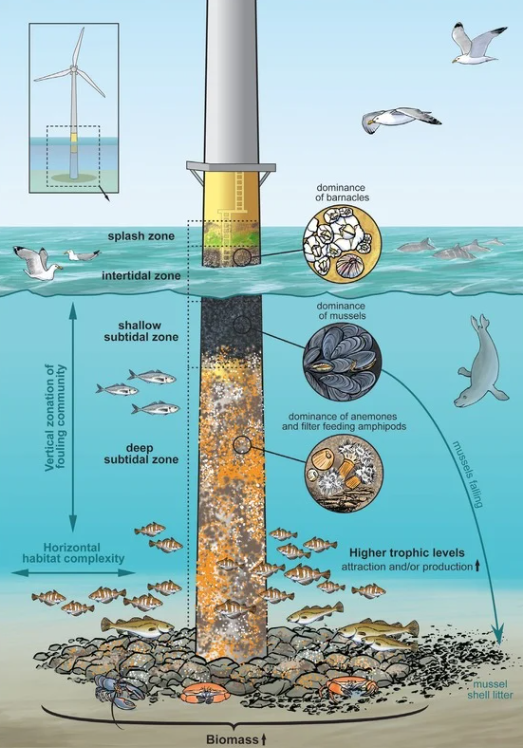Windfarms as Artificial Reefs
Offshore wind farm structures provide habitat for invertebrate organisms that foul the foundation along the depth gradient and attract predator fish, seabirds, and marine mammals. Illustration by Hendrik Gheerardyn. Oceanography 2020 | Vol.33, No.4
(https://creativecommons.org/ licenses/by/4.0/)
Artificial reefs are underwater structures designed to mimic the characteristics of natural reefs. These structures are made with a variety of hard surfaces, where algae and invertebrates attach, providing abundant food and hideouts for fish. Human-made reefs are important for conservation efforts to help regenerate marine habitats and boost biodiversity.
Recent research into the effects of windfarms on marine ecosystems discusses how the foundational bases of offshore wind turbines can serve as artificial reef habitats that provide shelter and feeding grounds for fish. Monopile, jacket, and gravity- based turbine foundations hold potential as nature-based solutions that produce renewable energy while simultaneously conserving marine life, enhancing fisheries.
Targeted research is underway to continue to assess the viability of windfarm foundations and the many ways they can be utilized to benefit marine ecosystems. Some companies are experimenting with how windfarms can be multi-use settings through aquaculture, by planting farms of shellfish and seaweed in-between the turbines. Farming blue mussels and sugar kelp is a sustainable method that improves water quality and nutrient density, not only providing food for humans, but also for marine animals.
Some windfarms in the North Sea are reporting up to 50% higher population densities than the nearby sandy areas, including species like cod, pouting, and flatfish. Preliminary research has shown that artificial reefs can support much higher biomass levels than surrounding areas. A seven-year study from Block Island showed how fish populations are benefiting from these structures. As windfarms progress, it will be interesting to discover novel possibilities for turbines to develop their capacity to foster marine biodiversity.

